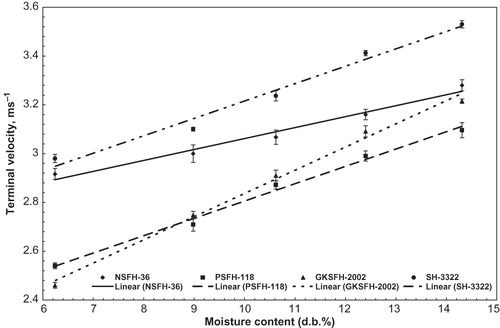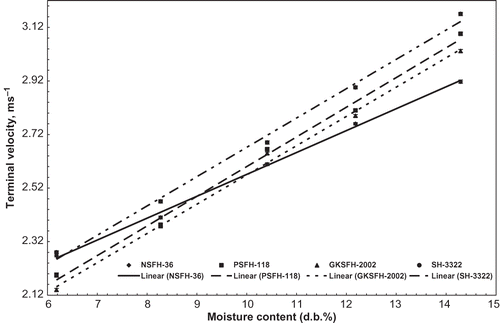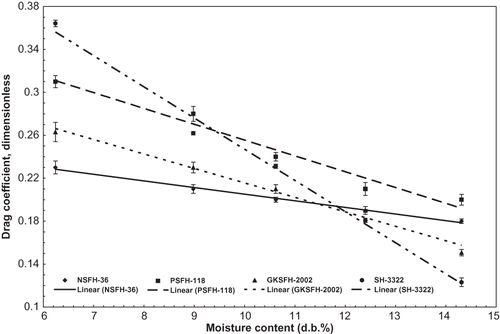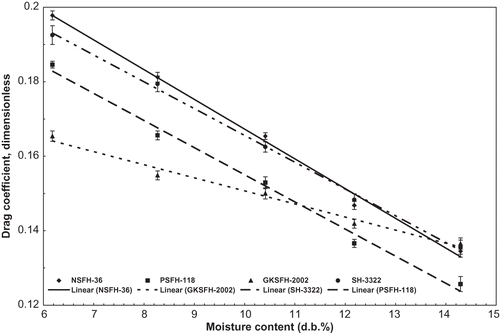Abstract
Aerodynamic characteristics of shelled and unshelled sunflower seeds of four cultivars, namely NSFH-36, PSFH-118, GKSFH-2002, and SH-3322, were evaluated as a function of moisture content. In the selected moisture range (6.2–14.4% d.b.), terminal velocity of unshelled seeds varied from 2.93–3.28, 2.54–3.04, 2.46–3.13, and 2.98–3.53 ms−1, whereas for shelled seeds it varied between 2.36–3.16, 2.22–3.06, 2.14–2.98, and 2.28–3.20 ms−1 for NSFH-36, PSFH-118, GKSFH-2002, and SH-3322 cultivars, respectively. The drag coefficient decreased from 0.23–0.18, 0.31–0.20, 0.27–0.16, and 0.36–0.12 in unshelled seeds, whereas, it varied between 0.19–0.13, 0.18–0.12, 0.16–0.14, and 0.19–0.13 in shelled seeds of NSFH-36, PSFH-118, GKSFH-2002, and SH-3322 cultivars, respectively. Statistical analysis showed that variation in moisture content, as well as cultivars, either individually or their interactions influenced the terminal velocity and drag coefficient of unshelled and shelled sunflower seeds significantly.
INTRODUCTION
Sunflower (Helianthus annuus L.) is an important oilseed crop because it contains a large quantity of highly nutritious oil.Citation[1] The aerodynamic properties and drag coefficient of agricultural products are important and required for the designing of air conveying systems and the separation equipment. The physical properties, such as density, shape, size, etc., are required for calculating the terminal velocity and drag coefficient of the agricultural produce. In the handling and processing of agricultural products, air is often used as a carrier for transport or for separating the desirable products from unwanted materials, therefore the aerodynamic properties, such as terminal velocity and drag coefficient, are needed for air conveying and pneumatic separation of materials.Citation[2] As the air velocity, greater than terminal velocity, lifts the particles to allow greater fall of a particle, the air velocity could be adjusted to a point just below the terminal velocity.Citation[3]
For most of the grains, as the moisture content increased, the terminal velocity also increased linearly. In the case of hazel nuts, it was revealed that with the increase in moisture content from 2.77 – 19.98% d.b. (dry basis), terminal velocity increased from 7.22 to 8.54 ms−1.Citation[4,Citation5] According to Nimkar et al.,Citation[6] terminal velocity was found to increase from 9.2 to 11.7 ms−1 in moth gram, when the moisture was increased from 7.33 to 33.57% (d.b.). Paksoy and AydinCitation[7] studied the effect of moisture content on air dependent properties of edible squash seeds and observed that when moisture content increased from 6.4 to 52.9% d.b., terminal velocity increased from 5.02 to 6.57 ms−1. Kashaninejad et al.Citation[8] studied the effect of moisture content on physical properties of pistachio kernels and found that terminal velocity increased from 6.45 to 7.32 ms−1 with increase in moisture content from 4.10 to 38.10 (% w.b. [wet basis]). Ozguven and VursavusCitation[9] observed the effect of moisture content on the physical properties of pine nut, hull, and kernel. Terminal velocity at 5.48% moisture content (dry basis) was found to be more for nut than kernel and hull. Similarly, it was reported that when moisture content was increased to 6.35, 9.87, and 15.22% d.b., the terminal velocity of the okra seeds increased from 5.20 to 5.68 ms−1.Citation[10] It was also noticed when moisture content was increased from 5.0 to 22.5% d.b., terminal velocity for millets increased from 2.75 to 4.63 ms−1.Citation[11] A similar increasing trend was observed for terminal velocity with an increase in moisture content for rapeseed,Citation[12] almond nut and kernel,Citation[13] and pigeon pea.Citation[14] Gezel et al.Citation[15] observed that terminal velocity for apricot kernel and apricot pit followed a linear relationship with their moisture content, and the terminal velocity for apricot kernel was found to be more than apricot pit. Kachru and RaiCitation[16] reported a higher terminal velocity for peanut pods containing multiple kernels than for pods containing a single kernel. Joshi et al.Citation[17] reported that for pumpkin seed, kernel, and hull, the variation in terminal velocity of each showed a linear relationship with their moisture contents. Scanty literature is available on the aerodynamic characteristics of the unshelled and shelled sunflower seeds. Thus, the present study was undertaken to study the effect of varied moisture level on the aerodynamic characteristics of unshelled and shelled sunflower seeds of the selected hybrid cultivars.
MATERIALS AND METHODS
Preparation of Samples
Four sunflower cultivars, namely NSFH-36, PSFH-118, GKSFH-2002, and SH-3322, were procured from the Department of Plant Breeding and Genetics, Punjab Agricultural University, Ludhiana, India and used for the experiment. Ten bulk samples, each consisting of 5 kg of seeds, were cleaned using the Air Screen Grain Cleaner for foreign matter, and broken and immature seeds. From this lot, unshelled seeds were randomly drawn for the experiment. This methodology was used to ensure the uniform sample size.Citation[18] Similarly, the shelled seeds were obtained by the manual dehulling of each cultivar. To study the effect of moisture content on terminal velocity and drag coefficient, samples of different cultivars at desired moisture levels (6.2–14.4 % d.b.) were prepared by adding calculated amounts of distilled water using EquationEq. (1).
where Q is the mass of water to be added (g), Wi is the initial mass of grain sample (g), mi is the initial moisture content of grain sample (% d.b.), and mf is the final moisture content of grain sample (% d.b.). The samples were kept at a low temperature (5°C) to avoid growth of microorganisms. Before starting the experiments, the required quantity of the sample was taken out of the refrigerator and was allowed to warm up to room temperature (27°C). Such wetting techniques to obtain the desired moisture content in grain was used by Shepherd and Bhardwaj.Citation[18] Also, Gupta and DasCitation[19] have used the same technique to get the desired moisture content for sunflower seeds. The moisture content was determined by an oven drying method.Citation[20]
Experimental Set-up
Experimental set-up for measurement of terminal velocity () was developed at the College of Agricultural Engineering, Punjab Agricultural University, Ludhiana, India. The sample was fed from a fixed distance (31 mm) from the aspirating mouth, which is well-rounded. The various parts of the experimental set-up are shown in . The connection of the hopper with the feed opening is arranged so that the latter exclude all secondary air. The vertical transparent column, therefore, has an equal and steady distribution of airflow in all cross sections to ensure an excellent suspension of grain. The heavy seeds fall downwards in the vertical transparent column and finally into the pan. Most of the seeds after remaining in suspension for 30 s are lifted upwards by the air and falls into a collecting interceptor. Between the vertical transparent column and ventilator is a screen that hinders the movement of the sample to get into the ventilator. Two measuring tubes served to determine the airflow rate. The terminal velocity of a particle may be defined as the air velocity at which a particle remains in a suspended state in the vertical transparent column. The terminal velocity (Vt ) was calculated, as per Kachru et al.,Citation[21] using the EquationEq. (2):
Determination of Terminal Velocity
The terminal velocity was measured using an experimental set-up, as described in . For each test, 100 g of sample was fed in to the hopper. The vibrator in the feeder dropped the seeds in to the air stream from the top of the vertical transparent column and air was blown in the upward direction to suspend the material in the air stream for 30 s. Setting the regulating device of the measuring tubes varied the airflow rate. Most of the seeds, after remaining in suspension for about 30 s, were carried away and collected in the collecting interceptor, and the heavier seeds, if any, fell in the pan below the vertical transparent column after suspension. The airflow rate was varied until the air stream lifted most of the seeds. This airflow rate was used to calculate the velocity using EquationEq. (2). The air velocity, which kept the seeds in suspension and was calculated, using EquationEq. (2), is termed as the terminal velocity of sunflower seed. All the experiments were carried out three times, unless stated otherwise, and the average values are reported.
Determination of Drag Coefficient
When a particle is immersed in a fluid current, the forces acting on the particle are Fv and Fh . If Fv is the drag force and Fh is lift force, then the resultant force, Fr , may be calculated by resolving these forces.Citation[2] It was assumed that the particle is smooth and having a projected area (Ap ), moving through a fluid of mass density ρ f , viscosity η, and modulus of elasticity E, with a velocity, V. The drag coefficient of the material and its resistance to airflow depends upon the bed thickness of the material, shape, and surface roughness of grain and the orientation of the material. In mathematical terms, it could be expressed as:
Using dimensional analysis technique, the drag and lift forces is:
The Cv and Ch are drag and lift coefficients of the material, respectively. The resultant force FR can be given as:
In the condition of free fall, the particle attains a constant velocity, Vt , the net gravitational accelerating force, Fg , equals the resisting upward drag force Fr :
By substituting the values of Fg and Fr , the terminal velocity can be expressed as:
or
L 1 and L 2 are the two largest dimensions of the unshelled and shelled sunflower seeds. The drag coefficient was calculated using EquationEq. (11). Mass density, ρ p , was determined experimentally using the liquid displacement method,Citation[19] whereas, the projected area, Ap , was estimated using EquationEq. (12). The values of the two largest dimensions of unshelled and shelled seeds (L 1 and L 2) were also measured using a micrometer (least count, 0.02 mm). The value of fluid mass density, such as air, ρ f , was taken as 1.2 kg m−3 at the temperature of 25°C.Citation[2] The analysis of variance (ANOVA) test was carried out using the SPSS 12.0 software (SPSS Inc., Chicago, IL) and the statistical procedures described by Gomez and GomezCitation[22] to examine the effect of moisture content and cultivars on terminal velocity and drag coefficient of both unshelled and shelled sunflower seeds.
RESULTS AND DISCUSSION
Terminal Velocity of Unshelled and Shelled Sunflower Seeds
and illustrate the effect of moisture level on the terminal velocity of unshelled and shelled sunflower, respectively. The terminal velocity of unshelled sunflower ranged from 2.92–3.28, 2.54–3.11, 2.46–3.22, and 2.98–3.53, whereas, in shelled it ranged from 2.27–2.92, 2.19–3.08, 2.14–3.03, and 2.28–3.17 ms−1 for NSFH-36, PSFH-118, GKSFH-2002, and SH-3322 cultivars, respectively. For each cultivar, a regression equation was developed for the terminal velocity with their respective R 2 (). It was observed that the moisture has linear positive effect on terminal velocity of sunflower unshelled, as well as shelled. Similar trends for terminal velocity were reported by Gupta and Das,Citation[19] Zewdu,Citation[23] Tunde-Akintunde and Olajide,Citation[24] and Unal et al.Citation[25] as a function of moisture content. A wider variation for terminal velocity values were observed for unshelled than shelled seeds among all the sunflower cultivars. This might be due to the least variation in the spatial dimensions of shelled seeds than for the unshelled seed. The maximum terminal velocity was observed for cultivar SH-3322 of unshelled and shelled seeds. The minimum value of terminal velocity was observed for GKSFH-2002 initially, but later it exceeds PSFH-118 with the increase of moisture level in case of unshelled seeds. Similarly, in case of shelled, the minimum value of terminal velocity was also recorded for GKSFH-2002, but later with the increase of moisture the value exceeds NSFH-36 ().
Table 1 Regression equations and R 2 (coefficient of determination) for various aerodynamic characteristics of unshelled and shelled sunflower seeds
Drag Coefficient of Unshelled and Shelled Sunflower Seeds
The effects of moisture on the drag coefficient of unshelled and shelled sunflowers are shown in and , respectively. The regression equation for the drag coefficient of each cultivar with their corresponding R 2 is given in . The drag coefficient decreased linearly both in unshelled and shelled seeds with the increase of moisture content. ZewduCitation[23] also reported the linear effect of moisture content on drag coefficient. The variation of drag coefficient for unshelled ranged between 0.23–0.18, 0.31–0.22, 0.26–0.15, and 0.36–0.12; however, in shelled it ranged from 0.19–0.13, 0.18–0.13, 0.17–0.14, and 0.19–0.13 for NSFH-36, PSFH-118, GKSFH-2002, and SH-3322 cultivars, respectively. In case of unshelled seeds, the maximum value of drag coefficient was observed for PSFH-118, while the maximum for GKSFH-2002 was observed in the kernel. In comparison, the decrease in drag coefficient was more pronounced in SH-3322 and PSFH-118 cultivars in unshelled and shelled sunflower seeds, respectively.
Analysis of Variance
The results of ANOVA showing the effect of moisture, cultivar, and their interactions on terminal velocity and drag coefficient of unshelled and shelled sunflower seeds are presented in and , respectively. The individual effect of moisture content and cultivars on terminal velocity and drag coefficient of unshelled and shelled sunflower seed was found significant (p ≤ 0.05). Similarly, the interactions of moisture content and cultivars was also found to have a significant effect on terminal velocity and drag coefficient of unshelled () and shelled () sunflower seeds. It was apparent that the variation in these factors either individually or in combination (interactions) significantly influenced the measured parameters vs. terminal velocity and drag coefficient. Thus, this indicates the interdependence between two variables, such as the deviation in any of these variables, would affect the terminal velocity and drag coefficient to a great extent.
Table 2 ANOVA to examine effect of moisture and cultivars on aerodynamic properties of unshelled sunflower seeds
Table 3 ANOVA to examine effect of moisture and cultivar on aerodynamic characteristics of shelled sunflower seeds
CONCLUSION
The terminal velocity and drag coefficient of the unshelled and shelled sunflower seeds varied significantly as a function of moisture content and cultivars. The terminal velocity increased, while the drag coefficient decreased with the increase of moisture content. In all the cultivars, values observed for both terminal velocity and drag coefficient were recorded higher in unshelled than shelled seeds at all moisture contents. Statistically, variation in moisture content and cultivars either individually or in combination (interactions) significantly influenced the terminal velocity and drag coefficient of unshelled and shelled sunflower seeds.
REFERENCES
- Shukla , B.D. , Srivastava , P.K. and Gupta , R.K. 1992 . Oilseed Processing Technology , India : CIAE .
- Sahay , K.M. and Singh , K.K. 1994 . Unit Operations of Agricultural Processing , New Delhi : Vikas Publishing House .
- Mohsenin , N.N. 1980 . Physical Properties of Plant and Animal Materials , New York : Gordon and Breach Science Publishers .
- Aydin , C. 2002 . Physical properties of hazel nuts . Biosystems Engineering , 82 : 297 – 303 .
- Demir , F. and Akinci , I. 2004 . Physical and nutritional properties of four major commercial Turkish hazelnut varieties . Journal of Food Engineering , 63 : 341 – 347 .
- Nimkar , P.M. , Mandwe , D.S. and Dudhe , R.M. 2005 . Physical properties of moth gram . Biosystems Engineering , 91 : 183 – 189 .
- Paksoy , M. and Aydin , C. 2004 . Some physical properties of edible squash (Cucurbita pepo L.) seeds . Journal of Food Engineering , 65 : 225 – 231 .
- Kashaninejad , M. , Mortazavi , A. , Safekordi , A. and Tabil , L.G. 2006 . Some physical properties of pistachio (Pistacia vera L.) nut and its kernel . Journal of Food Engineering , 72 : 30 – 38 .
- Ozguven , F. and Vursavus , K. 2005 . Some physical, mechanical, and aerodynamic properties of pine (Pinus pinea) nuts . Journal of Food Engineering , 68 : 191 – 196 .
- Calısır , S. , Ozcan , M. , Hacıseferoğulları , H. and Yıldız , M.U. 2005 . A study on some physico-chemical properties of Turkey okra (Hibiscus esculenta L.) seeds . Journal of Food Engineering , 68 : 73 – 78 .
- Baryeh , E.A. 2002 . Physical properties of millet . Journal of Food Engineering , 51 : 39 – 46 .
- Calısır , S. , Marakoglu , T. , Ogut , H. and Ozturk , O. 2005 . Physical properties of rapeseed (Brassica napus oleifera ) . Journal of Food Engineering , 69 : 61 – 66 .
- Aydin , C. 2003 . Physical properties of almond nut and kernel . Journal of Food Engineering , 60 : 315 – 320 .
- Baryeh , E.A. and Mangope , B.K. 2002 . Some physical properties of QP-38 cultivar pigeon pea . Journal of Food Engineering , 56 : 59 – 65 .
- Gezel , H. , Ulları , H. and Demir , F. 2003 . Some physical properties of Hacıhalilo lu apricot pit and its kernel . Journal of Food Engineering , 56 : 49 – 57 .
- Kachru , R.P. and Rai , D.R. 1993 . Physical constituents and some engineering properties of peanut pods . Journal of Oilseeds Research , 10 : 145 – 153 .
- Joshi , D.C. , Das , S.K. and Mukherjee , R.K. 1993 . Physical properties of pumpkin seeds . Journal of Agricultural Engineering Research , 54 : 219 – 229 .
- Shepherd , H. and Bhardwaj , R.K. 1986 . Moisture dependent physical properties of pigeon pea . Journal of Agricultural Engineering Research , 35 : 259 – 268 .
- Gupta , R.K. and Das , S.K. 1997 . Physical properties of sunflower seeds . Journal of Agricultural Engineering Research , 66 : 1 – 8 .
- Bureau of Indian Standards . 1996 . Indian standard method of oilseeds. IS: 3579 , New Delhi , , India : Indian Standards Institute .
- Kachru , R.P. , Gupta , R.K. and Alam , A. 1994 . Physico-Chemical Constituents and Engineering Properties of Food Crops , India : Scientific Publishers .
- Gomez , A.K. and Gomez , A.A. 1984 . Statistical Procedures for Agricultural Research , 2nd , Singapore : John Wiley and Sons Inc .
- Zewdu , A.D. 2007 . Aerodynamic properties of tef grains and straw material . Biosystems Engineering , 98 : 304 – 309 .
- Tunde-Akintunde , T.Y. , Olajide , J.O. and Akintunde , B.O. 2005 . Mass-volume-area related and mechanical properties of soybean as a function of moisture and variety . International Journal of Food Properties , 8 : 449 – 456 .
- Unal , H. , Isık , E. , Izli , N. and Tekin , Y. 2008 . Geometric and mechanical properties of mung bean (Vigna Radiata L.) grain: Effect of moisture . International Journal of Food Properties , 11 : 585 – 599 .




